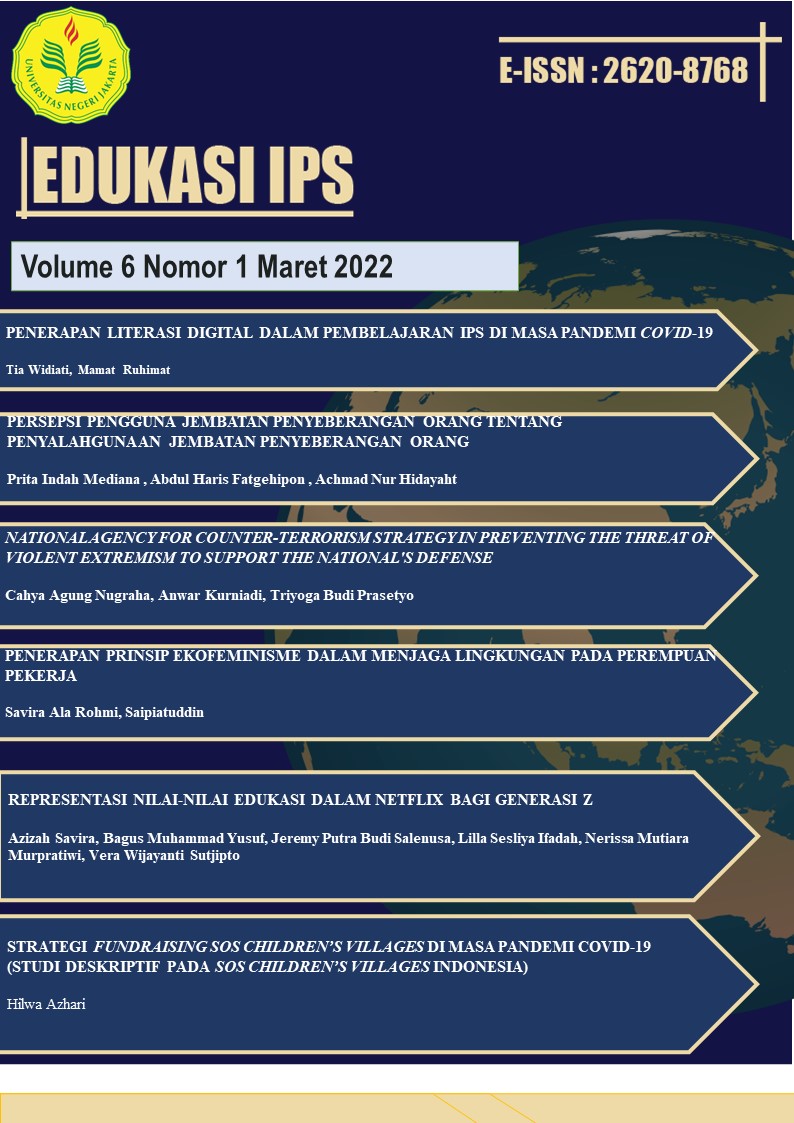National Agency For Counter-Terrorism Strategy In Preventing The Threat Of Violent Extremism To Support The National's Defense
DOI:
https://doi.org/10.21009/EIPS.006.01.03Keywords:
Consept of State Defense, Strategy, Synergy, Threats and Violent ExtremismAbstract
Abstract
Violent extremism is an asymmetric threat that can have an impact on the country's defense in Indonesia. The Strategy of BNPT is one of the efforts to prevent the problem. The aim of the study is to analyze the strategy of BNPT in preventing the threat of violent extremism as well as its synergy with ministries and institutions to support the country's defense. The method used in this study is a qualitative method by deepening from various sources on the national action plan to prevent violent extremism by BNPT. The theories used are defense concept theory, strategy theory, synergy theory, threat theory, violent extremism theory. The results of this study show that the strategy of BNPT aims to improve the protection of the right to the security of citizens from violent extremism through the establishment of Sekretariat Bersama and the Pokja Pilar I, II, III and Tematik Teams as a means to carry out violence extremism prevention actions through cooperation with ministries, institutions, and local governments. Synergy with Kementerian Koordinator Politik Hukum dan Keamanan through aligning the objectives of each ministry so as to obtain appropriate policies through the release of a guidebook on preventing radicalism and violent extremism in the environment of state-owned enterprises and private companies. On the other hand, synergy with Kementerian Agama Affairs through grounding religious moderation on social media, providing training to Islamic Religious Extension (PAI) and supporting deradicalization programs. Finally, with Kementerian Komunikasi dan Informatika through a creative campaign on social media with BNPT media, namely the Pusat Media Damai
Keywords: Consept of State Defense, Strategy, Synergy, Threats and Violent Extremism
Abstrak
Ekstremisme kekerasan merupakan ancaman asimetris yang dapat memberikan dampak terhadap pertahanan negara di Indonesia. Strategi Badan Nasional Penanggulangan Terorisme menjadi salah satu upaya dalam mencegah permasalahan tersebut. Tujuan penelitian ini adalah untuk menganalisis strategi Badan Nasional Penanggulangan Terorisme dalam mencegah ancaman ekstremisme kekerasan serta sinerginya dengan kementerian dan Lembaga guna mendukung pertahanan negara. Metode yang digunakan dalam penelitian ini adalah metode kualitatif dengan melakukan pendalaman dari berbagai sumber mengenai rencana aksi nasional pencegahan ekstremisme kekerasan yang dilakukan Badan Nasional Penanggulangan Terorisme. Teori yang digunakan adalah teori konsep pertahanan, teori strategi, teori sinergi, teori ancaman, teori ekstremisme kekerasan. Hasil penelitian ini menunjukan bahwa strategi Badan Nasional Penanggulangan Terorisme bertujuan untuk meningkatkan perlindungan hak atas rasa aman warga negara dari ekstremisme kekerasan melalui pembentukan Sekretariat Bersama serta Tim Pokja Pilar I,II,III dan Tematis sebagai sarana untuk melakukan aksi pencegahan ekstremisme kekerasan melalui kerjasama dengan kementerian, lembaga, dan pemerintah daerah. Sinergi dengan Kementerian Koordinator Bidang Politik Hukum dan Keamanan melalui menyeleraskan tujuan masing-masing kementerian sehingga mendapatkan kebijakan yang sesuai melalui merilis buku panduan pencegahan radikalisme dan ekstremisme kekerasan di lingkungan badan usaha milik negara dan perusahaan swasta. Di sisi lain, sinergi dengan Kementerian Agama melalui membumikan moderasi beragama di media sosial, memberikan pelatihan kepada Penyuluh Agama Islam (PAI) serta mendukung program deradikalisasi. Terakhir, dengan Kementerian Komunikasi dan Informatika melalui kampanye kreatif di media sosial bersama media BNPT yaitu Pusat Media Damai.
Kata kunci: Ancaman, Ekstremisme Kekerasan, Konsep Pertahanan Negara, Sinergi, dan Strategi
Downloads
Published
How to Cite
Issue
Section
License
Authors who publish with this journal agree to the following terms:
- Authors retain copyright and grant the journal right of first publication with the work simultaneously licensed under a Creative Commons Attribution ShareAlike License that allows others to share the work with an acknowledgement of the work's authorship and initial publication in this journal.
- Authors are able to enter into separate, additional contractual arrangements for the non-exclusive distribution of the journal's published version of the work (e.g., post it to an institutional repository or publish it in a book), with an acknowledgement of its initial publication in this journal.
- Authors are permitted and encouraged to post their work online (e.g., in institutional repositories, pre-prints sites or on their website) prior to and during the submission process, as it can lead to productive exchanges, as well as earlier and greater dissemination of published work







